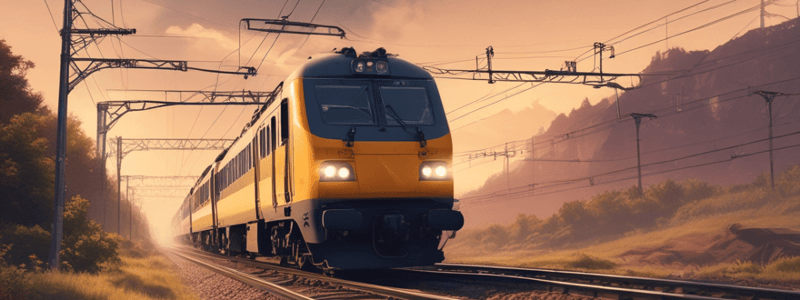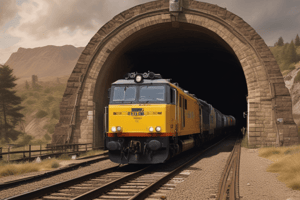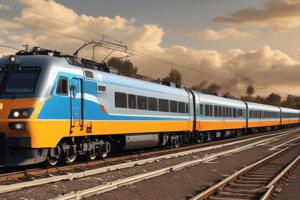Podcast
Questions and Answers
In what direction are emergency crossovers between double or multiple straight lines laid?
In what direction are emergency crossovers between double or multiple straight lines laid?
trailing direction
What type of turnouts may be used for snag dead end?
What type of turnouts may be used for snag dead end?
1 in 8½ symmetrical split turnouts
Why is it desirable to avoid laying turnouts on curved main lines?
Why is it desirable to avoid laying turnouts on curved main lines?
due to maintainability and comfort considerations
What is the minimum radius of the main line curve and resultant lead curve radius when laying turnouts with 1 in 12 or flatter crossings?
What is the minimum radius of the main line curve and resultant lead curve radius when laying turnouts with 1 in 12 or flatter crossings?
From which part of a curved track should 1 in 8.5 turnouts not be laid?
From which part of a curved track should 1 in 8.5 turnouts not be laid?
Under what circumstances can 1 in 8½ turnouts with curved switches be laid from outside of a curve?
Under what circumstances can 1 in 8½ turnouts with curved switches be laid from outside of a curve?
Why is it essential to select the proposed versines carefully in re-alignment solution?
Why is it essential to select the proposed versines carefully in re-alignment solution?
What is the purpose of using a steel tape in staking out the revised alignment of the curve?
What is the purpose of using a steel tape in staking out the revised alignment of the curve?
Why may it be necessary to drive pegs on the outer cess in narrow cuttings or tunnels?
Why may it be necessary to drive pegs on the outer cess in narrow cuttings or tunnels?
What should be verified after measuring the versines on the pegs?
What should be verified after measuring the versines on the pegs?
Where should the pegs not be fixed?
Where should the pegs not be fixed?
What should be done after slewing the curve to the revised alignment?
What should be done after slewing the curve to the revised alignment?
What is the importance of paying attention to the run-off on the transition?
What is the importance of paying attention to the run-off on the transition?
What is the purpose of Operation No. 3 in the re-alignment process?
What is the purpose of Operation No. 3 in the re-alignment process?
What type of features should be recorded that restrict slewing of the track?
What type of features should be recorded that restrict slewing of the track?
What should be measured and recorded against each station?
What should be measured and recorded against each station?
What is the purpose of recording the versine in a curve?
What is the purpose of recording the versine in a curve?
How should the versine survey be conducted in the case of reverse curves?
How should the versine survey be conducted in the case of reverse curves?
What information should be included in the record of the survey?
What information should be included in the record of the survey?
What is the purpose of recording the 'remarks regarding restrictions to slewing'?
What is the purpose of recording the 'remarks regarding restrictions to slewing'?
What is the significance of the 'GB' notation in the remarks column?
What is the significance of the 'GB' notation in the remarks column?
Why is it essential to record the 'High Bank, Moorum, etc.' in the remarks column?
Why is it essential to record the 'High Bank, Moorum, etc.' in the remarks column?
Why should each curve on double or multiple tracks be string-lined independently?
Why should each curve on double or multiple tracks be string-lined independently?
What is the purpose of cutting rails on curves?
What is the purpose of cutting rails on curves?
What is the formula to calculate the excess length 'd' by which the inner rail gains over the outer rail on a curve?
What is the formula to calculate the excess length 'd' by which the inner rail gains over the outer rail on a curve?
What happens when the inner rail of the curve is ahead of the outer rail by an amount equal to half the pitch of boltholes?
What happens when the inner rail of the curve is ahead of the outer rail by an amount equal to half the pitch of boltholes?
Why is it important to remark cant values on the inside web of the inner rail?
Why is it important to remark cant values on the inside web of the inner rail?
What is the purpose of repositioning posts on the cess?
What is the purpose of repositioning posts on the cess?
Why do transitions at the entry and exit of curved tracks have different lengths?
Why do transitions at the entry and exit of curved tracks have different lengths?
What is a cut rail?
What is a cut rail?
What is the requirement for laying points and crossings?
What is the requirement for laying points and crossings?
What is the restriction on junction fishplates in points and crossings?
What is the restriction on junction fishplates in points and crossings?
What is the requirement for the section of rails on either side of points and crossings?
What is the requirement for the section of rails on either side of points and crossings?
What is the preferred method of joining stock and lead joints on points and crossings assembly?
What is the preferred method of joining stock and lead joints on points and crossings assembly?
Where are spherical washers used in points and crossings assembly?
Where are spherical washers used in points and crossings assembly?
What is the importance of correct spacing of sleepers in points and crossings?
What is the importance of correct spacing of sleepers in points and crossings?
What is the requirement for the track geometry at the turnout?
What is the requirement for the track geometry at the turnout?
What is the requirement for clearance at the toe, heel of switch, at checkrail and wing rail?
What is the requirement for clearance at the toe, heel of switch, at checkrail and wing rail?
Flashcards are hidden until you start studying
Study Notes
Track Alignment and Maintenance
- Emergency crossovers between double or multiple straight lines can be laid with 1 in 8½ crossings in the trailing direction.
- 1 in 8½ symmetrical split turnouts may be used for snag dead ends.
- Turnouts have inbuilt curvature as part of their design, and laying them on curved main lines should be avoided for maintainability and comfort reasons.
Laying Turnouts on Curved Main Lines
- If laying turnouts on curved main lines is unavoidable, the following stipulations apply:
- For 1 in 12 or flatter crossings, the resultant lead curve radius and main line curve radius should not be less than 350m.
- 1 in 8.5 turnouts should not be laid from the inside of a curved track.
- 1 in 8½ turnouts with curved switches may be laid from the outside of a curve up to five degrees in exceptional circumstances with PCE approval.
Realigning Curves
- To achieve a suitable realignment solution, proposed versines should be selected carefully.
- A numerical example is given in Table 1 to illustrate the method of working out the solution for realignment of a curve.
- The revised alignment of the curve should be staked out with a steel tape by using pegs cut from bars or wooden stakes with tack marks.
Slew Operations
- The curve should be slewed to the revised alignment with reference to the pegs.
- Super-elevation should be provided at each station to accord with the curvature, with attention paid to run-off on the transition.
- Certain features that restrict slewing of the track either inwards or outwards should be recorded.
Recording Track Geometry
- The existing super-elevation should be measured and recorded against each station.
- The record obtained should be in the following form, including station, versine, cant existing, and remarks regarding restrictions to slewing.
Realignment of Curves on Double or Multiple Lines
- Each curve on double or multiple tracks should be string-lined independently.
- No attempt should be made to realign any curve by slewing it to a uniform centre-to-centre distance from the realigned curve.
Cutting of Rails on Curves
- Rails are usually laid with square fish-plated joints on curves.
- Cut rails should be provided to obtain square joints when the inner rail of the curve is ahead of the outer rail by an amount equal to half the pitch of boltholes.
- The excess length 'd' can be calculated by the formula: d = L × G / R.
Inspection and Maintenance of Points and Crossings
- Points and crossings should be laid without 1 in 20 cant unless otherwise specified in the drawing.
- There should be no junction fishplates at stock rail joints or at the heel of crossings.
- At least one rail on either side of the points and crossings should have the same section as the points and crossings assembly rail section.
Studying That Suits You
Use AI to generate personalized quizzes and flashcards to suit your learning preferences.




